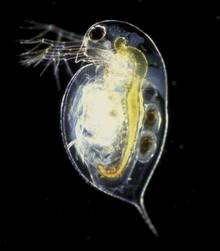Daphnia
| Daphnia | |
|---|---|
 |
|
| Daphnia pulex | |
| Scientific classification | |
| Kingdom: | Animalia |
| Phylum: | Arthropoda |
| Subphylum: | Crustacea |
| Class: | Branchiopoda |
| Order: | Cladocera |
| Family: | Daphniidae |
| Genus: |
Daphnia Müller, 1785 |
| Subgenera | |
|
|
| Diversity | |
| > 200 spp. | |
| Synonyms | |
|
|
Daphnia, a genus of small planktonic crustaceans, are 0.2–5 millimetres (0.01–0.20 in) in length. Daphnia are members of the order Cladocera, and are one of the several small aquatic crustaceans commonly called water fleas because their saltatory () swimming style resembles the movements of fleas. Daphnia live in various aquatic environments ranging from acidic swamps to freshwater lakes, ponds, streams and rivers.
The two most readily available species of Daphnia are D. pulex (small and most common) and D. magna (large). They are often associated with a related genus in the order Cladocera: Moina, which is in the Moinidae family instead of Daphniidae and is much smaller than D. pulex (approximately half the maximum length). Daphnia eggs for sale are generally enclosed in ephippia (a thick shell, consisting of two chitinous plates, that encloses and protects the winter eggs of a cladoceran).
The body of Daphnia is usually 1–5 millimetres (0.04–0.20 in) long, and is divided into segments, although this division is not visible. The head is fused, and is generally bent down towards the body with a visible notch separating the two. In most species, the rest of the body is covered by a carapace, with a ventral gap in which the five or six pairs of legs lie. The most prominent features are the compound eyes, the second antennae, and a pair of abdominal setae. In many species, the carapace is translucent or nearly so and as a result they make excellent subjects for the microscope as one can observe the beating heart.
...
Wikipedia
